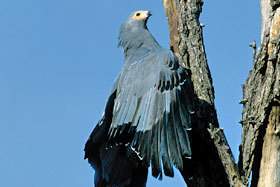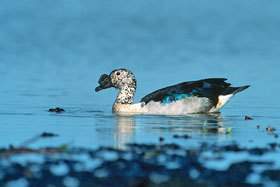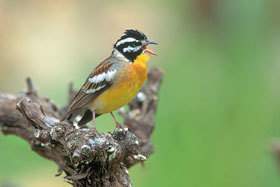
Birding Map for Kruger Parks' Skukuza and Surrounding Area
- Skukuza and Surrounds
- Phabeni Gate to Skukuza
- Paul Kruger Gate to Skukuza
- Skukuza to Lower Sabie
- Tshokwane to Satara
The Main Sabie River Road (H4-1)
The Sabie has entered a new bush development cycle in the wake of the 2000 floods which changed all the sandbanks and cleared the watercourse of many old trees.
Birds to look out for here are the Water Thick-knee*, Little Bee-eater, Green Twinspot (an occasional winter migrant from the thick bush on the escarpment), Burnt-necked Eremomela, Trumpeter Hornbill and if one's luck is in, perhaps even the elusive Narina Trogon.
 The high-level bridge over the Sabie River just east of its confluence with the Sand is a fine birding spot. Kruger birding expert Ian Whyte believes this is one of the best places in the Park to see the Half-collared Kingfisher, African Finfoot and African Black Duck.
The high-level bridge over the Sabie River just east of its confluence with the Sand is a fine birding spot. Kruger birding expert Ian Whyte believes this is one of the best places in the Park to see the Half-collared Kingfisher, African Finfoot and African Black Duck.
The Lower Sabie Road to Nkuhlu has some of the most beautiful trees in southern Kruger. Nkuhlu Picnic Site is a well-situated refreshment halt with terraced views over the river.
The landscape between Nkuhlu and Lower Sabie opens up into lightly wooded grassland with good views over the river and surrounding bush. Grassland birds become more common. The N'watimhiri causeway is a recommended three-kilometre loop off the H4-1 as it gets right to the water's edge. See page 71 for Nkuhlu to Lower Sabie.
The Salitjie Road (S30)
 This road, named after a Shangaan chief, skirts the northern banks of the Sabie River before winding through mixed woodlands into the eastern grassland plains. There are fewer vantage points over the Sabie River than there are on the H4-1, but there are some wonderful, quiet pools where the shy African Finfoot can sometimes be seen.
This road, named after a Shangaan chief, skirts the northern banks of the Sabie River before winding through mixed woodlands into the eastern grassland plains. There are fewer vantage points over the Sabie River than there are on the H4-1, but there are some wonderful, quiet pools where the shy African Finfoot can sometimes be seen.
This is one of the better roads in Kruger for seeing the Common Scimitarbill*, a woodland bird that clambers about in small parties in trees, foraging for grubs and insects in the bark. From Mafotini Lookout Point one has the option of taking the Old Tshokwane Road north through the open grasslands or heading south to Lower Sabie.
Skukuza to Tshokwane (H1-2)
There are usually raptors above the alluvial floodplains formed by the Sabie and Sand Rivers. The road to Tshokwane climbs out of the Sabie River system through dense woodlands of bushwillow, terminalia and Round-leaved Bloodwood towards the central grasslands. There are many seed-eaters along this road, while insect-eaters include the Lilac-breasted Roller, Cape Glossy and Greater Blue-eared Starlings and the White-fronted Bee-eater.
Halfway between Skukuza and Tshokwane are the three Elephant Water Holes - Mantimahle, N'watindflopfu and Olifantsgat. They are not particularly good water holes for birding but the bush around them is often busy, particularly in summer. This area also seems to support a lot of woodpeckers - each with its own distinctive pecking rhythm - the most common being the Bearded Woodpecker.
The Orpen Plaque and Kruger Tablets are places to stretch the legs and admire the granite koppies, but they aren't particularly active birding areas. The Mocking Cliff-Chat nests near these rocks. Leeupan marks the start of the eastern grasslands. There are good views in all directions around the water hole with regular sightings of lions and vultures. It's also a good place to see both Black-chested and Brown Snake-Eagles whose habitats don't always overlap. In wetter years, Leeupan is well known for sightings of Lesser Moorhen and Allen's Gallinule.
The more expansive Silolweni Water Hole seems to have more birdlife with two dead trees with big Buffalo-Weaver nests in them. The waterbirds here include a variety of herons and storks, Fulvous Ducks, Spur-winged and Egyptian Geese. Freak weather along the Mozambican coastline can blow seabirds this far inland - an unperturbed-looking Grey-headed Gull has been recorded preening itself at Silolweni. Among the Kruger rarities seen here is the Little Bittern, which has bold black markings down its back.
 Who Says Size Doesn't Count?
Who Says Size Doesn't Count?
The Comb Duck (Sarkidiornis melanotos) - formerly known as the Knob-billed Duck - is an intra-African migrant that is commonly found in Kruger at water holes and temporary pans. Its mating patterns appear to be linked to the quality of its surroundings. In marginal areas with little food it is monogamous; in times and places of plenty it becomes polygamous, with a male having harems of up to 10 females.
The knob - or comb - is only found on the male and swells during breeding season. Unsurprisingly, females are attracted by the size of the male duck's protruberance, which is a symbol of social status and dominance.
Skukuza to Orpen / Satara via Nhlanguleni Road (S36)
On a good day, the Nhlanguleni Road is a raptor highway. It is a quieter alternative into the central grasslands than the main Satara Road from Skukuza because it bypasses Tshokwane. There is often a lot of animal activity between the turn-off to the S36 to Jones' Dam as there is a large patch of sweetveld grazing here.
The road passes through mixed broadleaf woodland on quite coarse, sandy soils through three secondary river systems - the Ripape, N'waswitsontso and Sweni catchment areas, which support a variety of woodland and mixed savanna species. In summer, the Red-backed Shrike is a common bird in the thorn thickets along this road.
Lugmag Dam is always worth a stop. The dam is on the Ripape River, which is often dry, so birding is much better during wet cycles when the higher water level brings the dam edge closer to the parking area. Lugmag is a good viewing spot for the summer migrant waterbirds, including the Curlew Sandpiper, Common Greenshank*, Woodland Kingfisher, African Openbill*, Yellow-billed Stork and Comb Duck*.
The Common Greenshank*, a summer visitor from Russia and eastern Europe, is a solitary bird that appears sporadically in the Park. Unlike most birds, it is not territorial and seems happy to join other species foraging along the water's edge for tadpoles, insects and small fish.
North of Nhlanguleni Picnic Site, the woodlands give way to more stunted vegetation. Birds to be seen in this environment include the Kurrichane Buttonquail, Golden-breasted Bunting and Kori Bustard.
Ngwenyeni Water Hole, just before the turn-off to the N'wasitsontso River road, is only accessible to guests at the Imbali private lodge. It is a favourite bathing place for vultures.
They take their baths from lunch time to late afternoon and are quite happy to share their ablutions with other vulture species - up to four different kinds of vulture will share a water hole with considerable more elegance than they do a carcass. Large numbers of Cape Vultures, White-headed Vultures, White-backed and Hooded Vultures are usually seen flying in their high, lazy circles above this road, checking out the landscape for kills.
Shortly before Muzandzeni Picnic Spot, the road crosses the Sweni River, which is noted for the dense pockets of Southern Lala-palms on the river banks, indicating the proximity of the tropics. This is a good place for the Martial Eagle, which is believed to nest in this area. In summer, there are a lot of cuckoos along the watercourses. North of the Sweni River, the woodlands become noticeably more stunted and thornveld prevails.
Birds that favour this stunted bushwillow woodland include the Black-crowned Tchagra, Purple Roller and the Long-tailed Paradise-Whydah. The Black-crowned Tchagra is a very vocal little bird, whistling and calling excitedly when its territory is threatened, and getting involved in very complex duets in which pairs whistle, babble, cluck and make harsh, tearing noises.
Tshokwane
In Kruger, let it be said, all roads lead to Tshokwane. This stop on the savanna highway between north and south has a picnic area, provision store, gift shop and fast-food outlet, making it a good spot for breakfast, lunch or refreshments while exploring the central Lebombo or the game-rich, southern-central grasslands.
Tshokwane suffers greatly from the 'beggar-bird' phenomenon, while monkeys, baboons and duiker also try and take advantage of the human source of food. Although there are a number of watercourses in the area, the lack of reliable water has prevented its development into an overnight camp.
 The picnic area is dominated by a giant Sausage-tree (Kigelia africana) that protrudes from a thatched shelter. A bird closely associated with the Tshokwane area is the Grey-headed Bush-Shrike, which forages through the mid-strata of woodland trees.
The picnic area is dominated by a giant Sausage-tree (Kigelia africana) that protrudes from a thatched shelter. A bird closely associated with the Tshokwane area is the Grey-headed Bush-Shrike, which forages through the mid-strata of woodland trees.
Other birds found in the Tshokwane woodlands include the Crested Barbet and the Blue-billed Firefinch.
Look out at Tshokwane for the Groundscraper Thrush. It will often visit the site of a braai the next morning to forage around for scraps. Its name in Shangaan is Xihandzamatala (Handza - to scrape; Matala - ash pits) indicating that this habit of visiting campfire sites goes back a long time.
Tshokwane is on the edge of the southern range of the African Mourning Dove, which becomes more common to the north. Studies in the Zambezi valley show that the African Mourning Dove favours Ana Trees for nesting. It builds its nests slighty higher than the 10,5 metre browsing line created by elephants.
Tshokwane to Lower Sabie (H10)
The road from Tshokwane to Lower Sabie is a deeply scenic drive through the Lebombo, down into the south-eastern grasslands. The drive should include a detour to Orpen Dam (4km west off the S32) with stop-offs at Nkumbe Lookout Point, Muntshe Hill and Mlondozi Dam. See Lower Sabie to Mlondozi
Orpen Dam
Orpen Dam is in the Lebombo and is fed by the N'waswitsontso River that cuts through the mountains on its way to Mozambique. The Senegal Lapwing* is often seen in the short grasslands of the area. Although it appears to be an inter-African migrant seen mostly in Kruger during summer, there does appear to be a resident population in the Park. It is usually seen all year round at Orpen dam, gathered in small flocks foraging for termites and other insects.
It often flies at night, calling with a rather mournful 'ti-hi-whoo'. Some researchers believe it takes to the wing after dark in order to more easily spot bush fires. By day, it is often seen in recently burnt grasslands where it picks about in the blackened grass for braaied veld morsels.
The White-backed Night-Heron, an uncommon and reclusive resident occurs here although it is not easily seen during the day. Look out for the African Jacana - this bird is unusual in that the female lays the eggs and then disappears, and the male rears the chicks.
 Jack and the Jacana
Jack and the Jacana
Have you heard the one about Jack Nicholson and the African Jacana? A Mala Mala ranger swears by an exchange he had with the American actor who was being taken on a bush drive in the private reserve adjoining Kruger. Nicholson listened avidly as the guide explained how the female African Jacana is more abundant with her sexual favours than the male of the species.
Indeed, the female Jacana appears quite contemptuous of her male counterpart and flees the nest soon after egg-laying to go and look for more fun, while the male bird rears the chicks alone. Nicholson nodded knowingly and in a weary response commented, 'Sounds familiar, sounds just like the women of Hollywood'.
Nkumbe Lookout Point
Nkumbe is one of the most dramatic lookout points in the Park. Nkumbe birds include a mixture of rock dwellers and seed-eaters such as the Black-backed Puffback, Southern Boubou, Chinspot Batis, White-browed Scrub-Robin*, and Southern Black Tit. The Black-backed Puffback is a fairly common Kruger bird - there are approximately 130 000 in the Park.
It is a fine nest builder using spiders' webs to bind strips of bark into a neat little cup often decorated with lichen on the outside. The Southern Boubou is a secretive bird that often hops along the ground under foliage cover, nabbing insects and geckos. It kills snails, either by bashing their shells against branches or wedging them in the fork of a tree so that it can tear out the flesh.
Nkumbe is an ideal habitat for Shelley's Francolin. This game bird is particularly active in the early morning when it calls in a shrill voice from the top of a rock, 'I'll drink your beer, I'll drink your beer'. Other Nkumbe regulars include the Yellow-bellied Eremomela, Yellow-throated Longclaw, Coqui Francolin and Mocking Cliff-Chat.
Several Shangaan names for birds are onomatopoeic - listen to the call of the Black-backed Puffback* to understand why it is called Phayomu or why the Golden-breasted Bunting is called Rhakweni. The Shangaan name for the African Hoopoe is Pupupu.
The time to visit Nkumbe is in late summer when falcons and kestrels often gather in huge flocks to build condition before they fly off on their long northern migration to eastern Asia. Most of these are Amur Falcons* and Lesser Kestrels.
Beyond Nkumbe the road drops out of the Lebombo and crosses the eastern savanna plains towards Lower Sabie. There are several excellent birding spots on the road, including the vleis at the foot of Muntshe Hill, Mlondozi Dam and the Sabie River crossing just below the camp. See Lower Sabie to Mlondozi.

